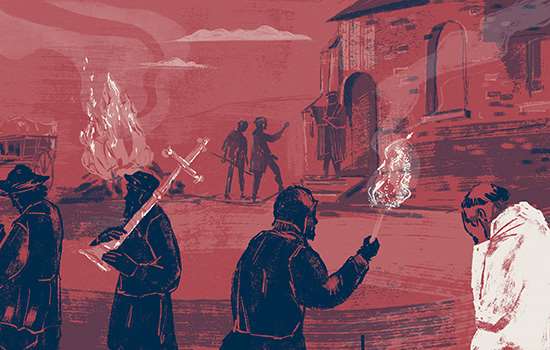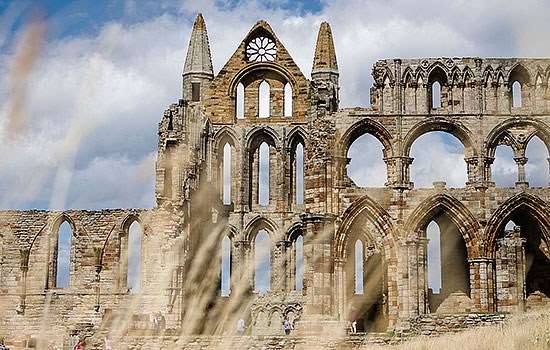Foundation
Hugh de Beauchamp, a powerful Norman lord, founded Bushmead Priory in about 1195–8. The first prior was William, the chaplain of a hermitage at Coppingford, about 1½ miles away. In 1198 Pope Innocent III issued a ‘bull’, or decree, extending his protection to William and the ‘brothers of the church of St Mary of Bushmead’. This wording suggests that the community was not then under monastic vows. This had changed by 1231, when Pope Gregory IX issued a further decree recognising the adoption of the Rule of St Augustine at Bushmead and granting the priory permission to allow laymen or clerks (men who had taken holy orders) to enter the community.
For the rest of the Middle Ages, Bushmead Priory was a house, or monastery, of Augustinian canons – a community of priests who lived according to the monastic rule attributed to St Augustine of Hippo (d. 430), one of the most important theologians of the Middle Ages. The Augustinians wore black habits, or robes, and because they lived a ‘canonical life’ (one subject to a rule) were called the Black Canons.
Bushmead was never a large or wealthy monastery. The community probably numbered at most six canons (and sometimes as few as three) and the founder’s initial grant of lands to the monastery was far from generous. However, thanks to the sustained benefaction of several landowning families – Bretville, Pertesol, le Daneys, le Moyne, Wildeboef and Braibroc – the priory was able to build up a modest endowment, with estates scattered across Bedfordshire, Cambridgeshire, Huntingdonshire and Northamptonshire. It also derived rents from properties in Bedford.
Canons and benefactors
It is clear from the charters making these gifts that the families supporting the priory valued the religious life there and the spiritual services offered by its canons. They believed that these services would hasten the passage of their souls through the pains of purgatory to everlasting bliss in heaven.
Burial at the priory was much esteemed, and no fewer than 24 grants to the monastery dating to the 13th and early 14th centuries specifically requested it. There were numerous endowments for the singing of commemoration masses. Seventeen grants of property came with instructions that the income was to be used to pay for ‘lights’ – candles or lamps – to burn during the celebration of the liturgy. Other benefactors endowed pittances – allowances of fine bread, wine or spices – which would be distributed to the canons on the anniversary of the death of the benefactors. In return, the canons would say commemorative prayers for the salvation of the benefactor’s soul.
On at least three occasions, the benefactors’ generosity secured them admission to the priory’s confraternity, or brotherhood. This meant that the benefactor was able to benefit from the full spiritual services of the priory as if they were a fully professed member of its community. Gifts to the priory also provided for especially fine wheat, which was used to bake communion wafers distributed at High Mass.
The priory and society
The canons were also called upon to fulfil more worldly duties. For instance, in 1227 Roger Pertesol deposited a legal document at Bushmead for safe keeping. The prior was occasionally asked to help gather the ‘subsidy’ (clerical taxation) and in 1249 Prior John de Wildeboef joined a fellow Augustinian during a visitation (or formal inspection) of Caldwell Priory.
Prior Wildeboef’s family were longstanding benefactors of the priory, and the surnames of several other priors and canons suggest that they too came from families tied to the priory or from nearby villages. Yet despite such ties, relations between the priory and its benefactors were not without conflict. For example, in 1333 a dispute between the monastery and its neighbours concerning unpaid rents and the impounding of its livestock reached the Court of Common Pleas in London (when judgment was made in favour of the canons). Several other such lawsuits are documented, some involving accusations of violence.
The priory’s buildings
All that remains of the priory is its 13th-century refectory and part of its associated kitchen. Information about its other buildings can, however, be gleaned from documentary sources.
The community of Prior William in about 1195–8 probably occupied pre-existing structures. A charter from this time mentions a ‘house’ at Bushmead. The ‘old chapel of St Mary’, doubtless the priory’s church, is documented in 1215. Evidence from charters suggests that this was rebuilt soon after. Between 1230 and 1250, the priory received two grants of land towards the ‘fabric’ of Bushmead’s church.
There were further building works in the 14th century. In 1310, special spiritual privileges were granted to people contributing to construction of the buildings, and 11 years later the canons were licensed to beg for charitable donations to fund their building works.
Documentary evidence tells us that there were chapels dedicated to the Virgin Mary, St Stephen and St Mary Magdalen in the priory church. A 13th-century grant to the priory provided for ‘ornaments’ in the church. Fragments of medieval and later stained glass, some of them doubtless made for the priory, have been reset in a rebuilt window in the refectory’s south wall. A fragmentary alabaster image recovered from the refectory is likely to be from an altarpiece once located in the church.
We know little about the priory’s other buildings. The main domestic structures were arranged around a cloister. Reversing the normal monastic layout, the church lay to the south of the cloister and the refectory to the north. This was presumably so that domestic buildings, including the kitchens and latrines, could be nearer to a water supply. To the east was the chapter house range, with a communal dormitory on the first floor.
The west side of the cloister, where in larger monasteries there would have been another range of buildings, was enclosed only by a wall. An infirmary, where sick and aged canons were cared for, is mentioned in a 13th-century charter, but its location remains unknown.
Charity and education
Bushmead also had a charitable role. In the early 13th century, one Helte Faucelun made a generous grant of lands to the priory to fund the feeding of 13 paupers each year on the feast of the Annunciation of the Virgin (25 March). Henry de Braybrooke’s gift of land in 1234 was used to house, feed and clothe five poor men at the priory. A descendant, Sir Gerard de Braybrooke, instructed in his will of 1427 that a requiem mass was to be sung for his soul at the priory. He provided funds to clothe 12 poor men who were to attend the service holding lighted tapers, and given 4d each as a reward.
In the mid 14th century Richard of Stoughton, one of the canons, received permission from the Bishop of Lincoln (in whose diocese Bushmead lay) to keep a school for the teaching of the ‘science of grammar’ to 60 boys. It is unclear if this school ever operated. Stoughton was elected prior in 1348, but died the next year, probably due to the Black Death which was then at its height.
The priory’s cartulary (a manuscript containing abstracts of the charters making gifts to the priory and summaries of its privileges) was written at around this time. Its whereabouts are now unknown, but an edition was published in 1945. Late 19th- and early 20th-century descriptions and reproductions show that it was the work of a highly skilled scribe. Several of the pages were ornamented with fine decorate penwork.
None of the books from the priory’s library is known to survive but there is some evidence to suggest that the community was well read. Two priors of Bushmead (Gregory of Norwich, 1493–1510, and Richard Smith, 1510–31) were university graduates.
Dissolution and later history
In 1530 a formal visitation of the priory by the Bishop of Lincoln found that all was well. Despite this, the priory was soon embroiled in the religious changes of Henry VIII’s reign. In 1534, the prior and community of three canons subscribed to the Act of Supremacy, recognising Henry VIII as head of the Church of England. A year later, Bushmead’s income was assessed at £71 13s 9d. The priory’s income and the small size of its community meant that it counted among the ‘lesser monasteries’ which were the first to be closed, and it was suppressed on 8 February 1536. The prior received a pension of £8.
In 1537 the king granted the site to Sir William Gascoigne, who had been a senior official in the household of Cardinal Thomas Wolsey. Fifteen years later Gascoigne sold it to William Gery. By 1620 buildings around the cloister of the former monastery had been converted into a substantial gentleman’s house.
Further alterations were planned in 1755, when another William Gery engaged the architect Isaac Ware to enlarge the house in the then fashionable Palladian style. This scheme was never executed, and the converted parts of the priory were instead later given a Georgian facade. This house was demolished in 1965, leaving only the former monastic refectory, which the Wade-Gery family placed in state guardianship in 1973.
Conservation and restoration
The Department of the Environment (a predecessor of English Heritage) then undertook a programme of conservation and restoration. This revealed substantial portions of 14th-century wall painting, including scenes from the Creation. Old Testament scenes are comparatively rarely depicted in English medieval wall paintings, and the narrative scheme of the Creation is without parallel among the few surviving figure subjects in English refectory paintings.
A substantial fragment of a 15th-century sculpted alabaster of an Augustinian canon was also discovered among the rubble infill of the west window.
A detailed analysis of the refectory’s timber roof revealed that it dates to about 1280–90 and has features in common with the contemporary roofs at Lincoln Cathedral and Salisbury Cathedral.
Further reading
NW Alcock, ‘Bushmead Priory, Bedfordshire: A thirteenth-century hall and roof’, Journal of the British Archaeological Association, 33 (1970), 50–56
GH Fowler and J Godber (eds), The Cartulary of Bushmead Priory, Bedfordshire Historical Record Society 22 (Streatley, 1945)
‘Houses of Austin canons: the priory of Bushmead’, in A History of the County of Bedford, vol 1, Victoria County History (London, 1904), 385–7 (accessed 6 Feb 2023)
D Park, ‘The Creation: marginalia and ornament in the refectory paintings of Bushmead Priory’, Bedfordshire Archaeology, 17 (1986), 72–6 (accessed 7 Nov 2023)
D Sherlock, ‘A medieval alabaster from Bushmead Priory’, Bedfordshire Archaeology, 14 (1980), 56–8 (accessed 7 Nov 2023)
D Sherlock, Bushmead Priory (English Heritage guidebook, London, 1985)
Find out more
-

Visit Bushmead Priory
Visit Bushmead Priory to see this rare survival of a complete Augustinian refectory, with notable 14th-century wall paintings and a fine timber roof.
-

WHAT BECAME OF THE MONKS AND NUNS AT THE DISSOLUTION?
Discover what happened to the many thousands of monks and nuns whose lives were changed forever when, on the orders of Henry VIII, every abbey and priory in England was closed.
-

ABBEYS AND PRIORIES
Learn about England’s medieval monasteries and uncover the stories of those who lived, worked and prayed in them.
-

MORE HISTORIES
Delve into our history pages to discover more about our sites, how they have changed over time, and who made them what they are today.
